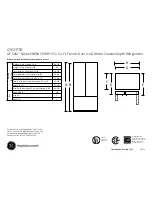
EN - 21
6 SHIPMENT AND
REPOSITIONING
6.1 Transportation and Changing
Positioning
•
The original packaging and foam may be
kept for re-transportation (optional).
•
Fasten your appliance with thick
packaging, bands or strong cords and
follow the instructions for transportation
on the packaging.
•
Remove all movable parts (shelves,
accessories, vegetable bins, and so on)
or fix them into the appliance against
shocks using bands when re-positioning
or transporting.
Always carry your appliance in the
upright position.
7 BEFORE CALLING AFTER-
SALES SERVICE
If your refrigerator is not working properly,
there may be a minor problem. Check the
following.
The appliance does not operate
Check if:
•
There is power
•
The mains is connected
• The thermostat setting is on the “•”
position
•
The socket is defective. To check this,
plug another working appliance into the
same socket.
The appliance performs poorly
Check if:
•
The appliance is overloaded
•
The doors are closed properly
•
There is any dust on the condenser
•
There is enough space near the rear and
side walls.
The appliance is noisy
The cooling gas which circulates in the
refrigerator circuit may make a slight
noise (bubbling sound) even when the
compressor is not running. Do not worry,
this is normal. If you hear a different sound,
check whether:
•
The appliance is level
•
Anything is touching the rear of the
appliance
•
Objects in the appliance are vibrating.
Your refrigerator is operating noisily
The following noises can be heard during
normal operation of the appliance.
Cracking (ice cracking) noise occurs:
•
During automatic defrosting.
•
When the appliance is cooled
or warmed (due to expansion of
appliance material).
Clicking noise occurs:
When the
thermostat switches the compressor on/
off.
Motor noise:
Indicates the compressor
is operating normally. The compressor
Summary of Contents for FFBIS5050
Page 1: ...Built in Freezer Fridge User Manual EN FFBIS5050...
Page 25: ...EN 25...
Page 26: ...EN 26...
Page 27: ...EN 27...
Page 28: ...52337895...








































